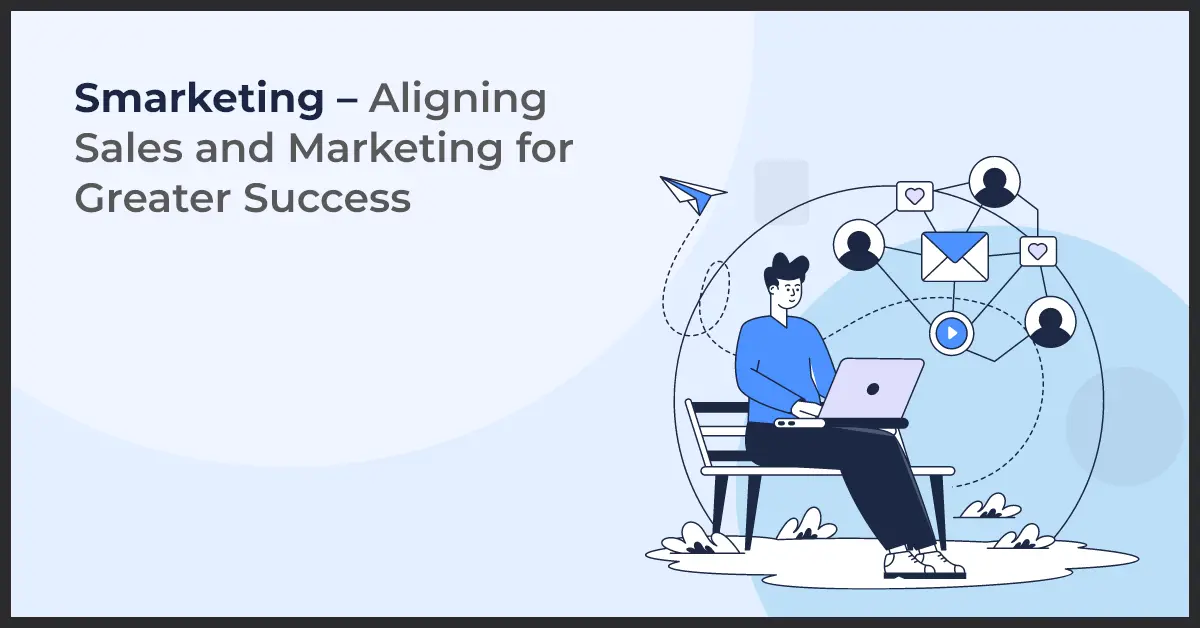Smarketing – Aligning Sales and Marketing for Business Growth

Published on: July 31, 2019
Updated on: March 17, 2025
2238 Views
- Digital Marketing
16 min read
“There is no sale without the story; no knockout without the setup.” – Gary Vaynerchuk
Smarketing – Aligning Sales and Marketing is an indispensable element in any organization’s success mantra, and saying otherwise would be, well, a broken record. In theory, it’s all rainbows and sunshine; practically, not so much! So, how can you make Smarketing – Aligning Sales and Marketing as in sync as Sherlock and Watson, Batman and Robin, or Bert and Ernie? You get the drift. We’ve broken it down for you.
5 Important Steps for Aligning Sales and Marketing – Smarketing
Here are 5 essential steps to establish an infallible ‘Sales + Marketing = Smarketing’ strategy:
1. Revenue Discussion and Agreement Between Sales and Marketing
B2B organizations with tightly aligned sales and marketing operations achieve 24% faster three-year revenue growth and 27% faster three-year profit growth. Shared revenue goals with well-defined service level agreements (SLAs) are sure to help you achieve this number. Numbers make ideas more realistic. Therefore, when sales talk about revenue per customer, deal size, etc, marketing is more likely to determine the number of viable leads that are needed to hit that number. Once that cat’s out of the bag, both sales and marketing would be more driven to closely working together than running in Schrodinger’s circles.
2. Focus on Strong Sales Enablement Tools
According to research, 76% of content marketers forget sales enablement, and 65% of sales reps say they can’t find content to send to prospects. This is nothing but a plague on sales and marketing alignment. Marketing works day in and day out on collaterals that help make the sales representatives ‘sales-intelligent’. These could be brochures, leaflets, presentations, case studies, etc. It’s important that marketing takes a step further and helps sales folks access these tools easily enough to make optimum use of them.
3. Closed-Loop Reporting
More than 80% of marketing leads never convert into sales. Whatever happens to those leads? Hence the need for closed-loop reporting. Not just to know the status of all leads but to run analysis on what is working and what is not in terms of sales. Understanding what marketing trends, channels, campaigns, and tactics are yielding the best results as far as sales are concerned because that is what really matters. It brings focus on the revenue impact of marketing versus the lead volume. Knowing what matters when it comes to closing more sales helps marketers focus on making sure they are cranking up the right channels and tactics and, in turn, get an up-to-date status of those leads. Closed-loop reporting also helps in identifying leaks and stalls in the sales and marketing funnel to help plug those holes. Sales benefit from closed-loop reporting too as it receives cleaner and better leads, thus increasing a lead-to-conversion rate and sales ROI.
4. Top-notch Sales and Marketing Technology
35-50% of sales go to businesses that respond first. Businesses are responding to leads at an average of 40 hours response time. If responding promptly isn’t a priority for you, what is? Aligning sales and marketing would always remain a far-fetched dream in the absence of a CRM and a marketing automation platform. Even with systems in place, most sales teams are either not receiving leads in real-time or sales follow-up process is not optimized. Make sure that the process between marketing and Sales handoff is tight and when results flow everyone will be inclined to follow the required best practices. Make sure you have the right level of commitment from all teams involved to ensure the success of your Martech and Salestech investments.
5. Campaign Deliberation Between Sales and Marketing
Companies with dynamic and adaptable sales & marketing processes report an average of 10% more salespeople on-quota compared to other companies. This step could be considered as the easiest upgrade for aligning sales and marketing. Since sales reps deal with prospects on the front line, they have a better and more explicit insight into the prospects’ needs. Marketing can make use of that insight for fashioning highly relevant content that should be sent out through campaigns (email, social media, paid, etc). This would give salespeople more than a sneak-peek into the marketing execution process, thus establishing higher understanding and confidence amongst the teams.
If you took a look at these steps as closely as we wanted you to, you’d have understood by now that the core of each of these steps is “Collaboration”. Regular sales and marketing meetings and catch-ups would help the respective team members develop confidence in their ideas, processes, and outcomes. Let these teams breathe easy and get rid of their ‘holier than thou’ outlook. Don’t let the taboo of misalignment hit you like a stupefy spell. Let genuine collaboration make your sales and marketing teams aligned like Sherlock & Watson, Batman & Robin, and Bert and Ernie. Yes, you get my drift!
Unlocking Growth with Smarketing: The Power of Sales & Marketing Synergy
Welcome to the cutting-edge world of smarketing! Ever heard the term tossed around and wondered what it's all about? You're in the right place. Smarketing is the clever blend of sales and marketing efforts to create a powerhouse of efficiency and growth for your business. The secret sauce to any thriving company isn't just stellar marketing or aggressive sales – it's when both departments lock steps in a dance of strategic alignment. In this blog post, we'll delve deep into how syncing your sales and marketing strategies can skyrocket your business success. Stick around to learn essential smarketing tactics, how to foster a shared vision between teams, and the resulting benefits for your bottom line. Let's bridge that gap together!
Understanding the Customer
At the heart of smarketing lies the need to deeply understand the customer. It's not just about knowing who they are, but also grasping why they make the choices they do, and what drives their purchasing decisions. The core aim here is to build a strong connection that goes beyond the superficial.
Customer Needs and Desires
To truly comprehend your customer's needs and desires, consider their pain points, their aspirations, and the problems they are trying to solve. This insight will not only inform product development but also shape your marketing messages and sales pitches.
Cognitive Empathy in Smarketing
By exercising cognitive empathy, sales and marketing teams can put themselves in their customer's shoes. This empathetic approach allows for more personalized, relevant, and ultimately, effective engagement with your target audience.
Building Customer Personas
- Demographics: Age, location, job title
- Behavior Patterns: Buying habits, brand interactions
- Motivations: What drives their loyalty and advocacy?
- Goals: Both personal and professional aspirations
With a solid understanding of your customer's world, smarketing efforts can be tailored to resonate on a deeper level, fostering a connection that's built to last. This isn't about selling a product; it's about providing a solution to a need, thereby creating value for the customer and building a lasting relationship.
The Role of the Customer in Smarketing
At the heart of every smarketing strategy lies the customer – the pivotal figure whose needs and behaviors shape the very approach businesses take. Embracing a customer-centric mindset is more than just a sound business practice; it's the linchpin of successful smarketing strategies. Let's delve into the transformative impact that customers have on the smarketing concept.
A Customer-Centric Approach in Business
In today’s market, businesses that prioritize the customer's experience above all else are the ones that stand out. Smarketing thrives on this principle by fostering a synergy between sales and marketing teams focused on serving the customer's needs and pain points at every stage of their journey.
How Smarketing Benefits the Customer
When smarketing is executed well, it results in a seamless experience for the customer. Sales and marketing efforts complement each other to deliver consistent messaging, timely interactions, and solutions that resonate with the customer's current and future requirements.
Customer Journey Mapping
Understanding the various points at which customers interact with your brand is essential. Through customer journey mapping, smarketing teams can visualize the customer's path and create a cohesive strategy that aligns with each phase of the journey, ensuring that the customer feels supported and understood.
Charting the Customer’s Path to Purchase
The path to purchase isn't a straight line; it's a winding road filled with informational pit-stops and decision-making detours. Smarketing helps delineate this path by analyzing the customer’s behavior, preferences, and feedback, ultimately shaping a journey that leads to satisfaction and loyalty.
Aligning Sales and Marketing Touchpoints
Every interaction with a customer is an opportunity to reinforce your brand's value and commitment to their success. By aligning sales and marketing touchpoints, smarketing ensures that whether it’s a promotional email or a sales call, the customer receives a unified experience that leverages the strengths of both teams.
In summary, the customer isn't just a part of the smarketing equation; they are the very reason for its existence. By acknowledging the customer's indispensable role and tailoring approaches accordingly, businesses can achieve the full potential of a smarketing strategy.
Unlock the Power of Smarketing Through Effective Communication
Imagine two gears in a well-oiled machine, working in perfect harmony to turn the wheels of success. That's the symbiotic relationship between sales and marketing when communication is at the forefront. But remember, smarketing isn't just about passing information back and forth; it's about crafting a conversation that builds understanding and drives results.
Why Does Communication Matter in Smarketing?
In the world of smarketing, communication is the lynchpin. It empowers teams to share insights, goals, and strategies - ensuring everyone is rowing in the same direction. It isn't just chatter; it's about creating a unified voice that resonates with every customer touchpoint. Let's break it down:
- Frequent Touchpoints: Regular interactions between sales and marketing lead to a deeper understanding of shared objectives.
- Transparency: Open lines of communication mitigate confusion and align teams under common goals and metrics.
- Feedback Loops: Continuous feedback from all stakeholders refines strategies and tactics in real time.
The magic happens when communication turns into collaboration—sparking innovation and leading your smarketing efforts to flourish. So, embrace it, encourage it, and watch how it transforms the way your teams work together!
Mastering the Art of Conversation in Smarketing
Getting sales and marketing teams to speak the same language is no small feat, but it's central to the success of smarketing. The fusion of communication strategies within smarketing is where the magic happens, building a bridge between the two worlds and ensuring they operate in harmony. Let's delve into how a solid communication framework can transform your business.
Building a Shared Language
When sales and marketing start to develop a shared language, misunderstandings begin to fade, and productivity skyrockets. This means creating common definitions for lead scoring, customer personas, and sales funnels. It's about making sure everyone is on the same page, literally and figuratively.
Fostering Effective Information Transfer
The role of communication in smarketing cannot be overstated. Effective information transfer between sales and marketing ensures that vital data, insights, and feedback flow seamlessly from one team to the other. This continuous exchange helps to refine strategies and tactics in real-time, keeping both teams agile and informed.
Creating a Rhythm of Collaboration
Implementing structures like regular meetings and shared dashboards provides the teams with touchpoints to connect, collaborate, and share progress. It's essential to foster a collaborative culture that encourages openness and trust, making communication more than a process—it becomes part of the DNA of how your teams operate.
- Regular Meetings: Weekly kick-offs, cross-departmental sync-ups, and monthly reviews are great practices to keep everyone in the loop.
- Shared Dashboards: Make use of digital platforms where sales and marketing data can be viewed and analyzed collectively, facilitating a unified approach to strategy adjustments.
- Collaborative Culture: Encourage team members to step into each other's shoes, commend cross-functional achievements, and promote empathy across departments.
By embracing these communication strategies within your smarketing efforts, you're not just aligning two departments—you're creating a powerhouse that can significantly elevate your company's performance.
Unleashing Potential: Process Optimization for Smarketing Success
Smarketing isn't just about aligning your sales and marketing team's goals and communication—it demands an optimized process to truly thrive. To achieve lasting success, smarketing must include a continuous improvement strategy within its core processes. Let's dive into how you can optimize your smarketing processes for peak efficiency and effectiveness.
Identify Bottlenecks and Streamline Workflow
In any process, identifying bottlenecks is crucial. Take a close look at your current smarketing workflow. Where are the hold-ups? Are leads getting stuck somewhere between marketing and sales? By pinpointing these areas, you can take targeted actions to streamline the flow from initial lead capture to final sale.
Implement Feedback Loops
Feedback is the lifeblood of improvement. Encourage constant feedback between your sales and marketing teams and act on it to refine your smarketing processes. Regular interdepartmental meetings can help facilitate this, ensuring that feedback is not only heard but integrated effectively.
Leverage Data Analytics
With the right data, process optimization is significantly more actionable. Use analytics to track the customer journey and your team's performance. Which marketing messages are resonating? Which sales approaches are converting? Use this data to optimize every step of the process.
Automate to Enhance Efficiency
Automation can be a smarketing game-changer. If there are manual tasks that slow down your team, look for opportunities to automate them. Automation tools can help in lead scoring, email marketing, and more, freeing your team to focus on personal interactions and complex decision-making.
Continuous Training and Development
For a process to remain optimized, your team's skills must be kept sharp. Invest in continuous training and development for both sales and marketing teams. As they grow in their capabilities, so too will your smarketing strategy evolve and improve.
Measure, Adjust, Repeat
No optimization process is set-it-and-forget-it. Establish KPIs (Key Performance Indicators) to measure the impact of your smarketing process improvements. Be prepared to adjust as needed, and make this iteration a regular part of your smarketing routine.
By investing in process optimization, your smarketing efforts can generate consistently better outcomes. It isn’t just about working harder; it's about working smarter, and with the right approach, your teams can become a well-oiled smarketing machine.
Unleashing the Power of Content within the Smarketing Ecosystem
The strategic role of content in smarketing is to serve as a cornerstone in educating and nurturing leads through the sales funnel. By providing valuable, relevant information, content marketing helps in addressing customer pain points and establishing thought leadership, all while subtly guiding them towards a purchase decision.
Furthermore, aligning the content strategy with sales objectives is essential for ensuring that each piece of content is not only brand-consistent but also tailored to support the goals of the sales team. This alignment means that marketing efforts are no longer spraying and praying, but instead, are striking with precision at the heart of sales targets.
Lastly, content is not just about attracting prospects; it is a potent tool that empowers the sales team. With the right content at their disposal, sales representatives can engage in meaningful conversations, provide immediate value to prospects, and progress leads through the buying journey with greater confidence and success.
- Utilize content to educate and inform prospects at every stage of the buyer's journey.
- Sync content creation with sales goals to maximize the impact on the bottom line.
- Leverage content to give sales reps an edge, with case studies, whitepapers, and more to support their pitches.
By weaving content marketing seamlessly into the smarketing framework, businesses can create a cohesive narrative that not only attracts but also converts, turning the wheels of the sales machine with greater efficiency and harmony.
Enhancing Targeted Outreach with Account-Based Marketing and Smarketing
Account-Based Marketing (ABM) and Smarketing are two strategies that, when combined, can result in a powerful approach to B2B marketing and sales. This integration focuses on tailoring campaigns to specific high-value accounts, ensuring that marketing and sales efforts are not just aligned, but exceptionally targeted.
Understanding the Intersection of ABM and Smarketing
At the core of ABM is the idea of concentrating on a carefully selected list of key accounts that have the highest potential for revenue. Smarketing contributes to the success of ABM by maintaining seamless alignment between the sales and marketing teams. This synergy ensures that both teams are working towards the same goals, utilizing data and insights to craft personalized experiences for each account.
Developing Target Account Strategies with a Smarketing Mindset
Developing a strategy for target accounts requires a smarketing approach that leverages both sales intelligence and marketing insights. This collaborative effort allows for the creation of content and messaging that resonates deeply with each target, addressing their unique challenges and business needs.
Customizing Sales and Marketing Efforts for High-Value Leads
Customization is the name of the game in ABM and its success is further amplified by smarketing. Integrating personalized marketing campaigns with tailored sales tactics ensures that high-value leads receive attention that is not just personalized, but also consistent across every touchpoint. This bespoke approach leads to a more engaging experience for potential clients and a higher chance of converting these prized accounts into loyal customers.
- Use data and customer insights to create hyper-focused campaigns.
- Align team objectives and define KPIs that reflect both sales and marketing achievements.
- Implement regular meetings and communication channels to ensure strategies and goals are continuously synced.
By considering both ABM and Smarketing in tandem, businesses can achieve a level of personalization and efficiency that stands out in today's competitive market. It’s about making the most out of high-value relationships with a proven, aligned strategy that drives growth and revenue.
Sealing the Smarketing Deal
Smarketing isn't just a buzzword; it's the future of synergistic business growth. By fusing sales and marketing into a cohesive unit, companies can unlock new levels of efficiency and success. As we've seen throughout our journey, the power of smarketing lies in unity—aligning goals, streamlining communication, and leveraging data-driven insights for a customer-centric approach.
In conclusion, remember that smarketing is not a one-off project but an ongoing strategy. It requires continuous effort, adaptation, and commitment from everyone involved. From embracing the latest technologies to fostering a culture of collaboration, everything counts when building a smarketing powerhouse.
- Alignment: Ensure that sales and marketing objectives are not just aligned, but unified.
- Communication: Keep lines of communication open, and share insights, challenges, and victories.
- Customer Focus: Always keep the customer at the heart of your strategies, and strive for an exceptional customer journey.
- Innovation: Embrace new tools and strategies to stay ahead in the ever-evolving landscape of smarketing.
As we move forward, let's carry the principles of smarketing into every campaign, meeting, and business decision. Together, let's break down silos, foster innovation, and drive our companies towards unprecedented success. The smarketing approach isn't merely a trend; it's the beacon guiding us towards a more collaborative and results-driven horizon.
Do you have a solid Sales and Marketing alignment?
If yes, great! If not, we’ve got your back! Just write to us at info@growthnatives.com and we’ll take it from there.
Source -
https://www.zoominfo.com/blog/sales/sales-and-marketing-alignment-statistics
https://www.conveyormg.com/blog/sales-marketing-alignment-statistics
Frequently Asked Questions
Smarketing is the strategic alignment and integration of sales and marketing teams to improve communication, enhance collaboration, and achieve common business goals, resulting in greater overall success for the organization.
Aligning sales and marketing ensures that both teams work towards shared objectives, reduces friction and misunderstandings, improves lead quality and conversion rates, enhances customer experience, and ultimately drives business growth.
Businesses can begin by fostering open communication between sales and marketing teams, setting common goals and metrics, conducting joint planning sessions, and implementing collaborative tools and technologies that facilitate information sharing.
Key benefits include improved lead generation and nurturing, more effective and personalized customer interactions, increased revenue and ROI, streamlined processes, better use of resources, and a unified approach to business strategy.
Strategies include holding regular joint meetings or workshops, establishing a shared content calendar, creating a feedback loop for lead quality and follow-up, incentivizing collaboration through shared goals and rewards, and fostering a culture of mutual respect and appreciation between teams.
Businesses can measure effectiveness through KPIs such as lead conversion rates, sales cycle length, customer acquisition costs, revenue generated from marketing-generated leads, customer lifetime value, and overall business growth and profitability.
Successful alignment leads to a seamless customer experience across the entire buyer’s journey, from initial awareness to post-purchase support. Consistent messaging, personalized interactions, and efficient handoffs between sales and marketing teams contribute to a positive and cohesive customer experience.



